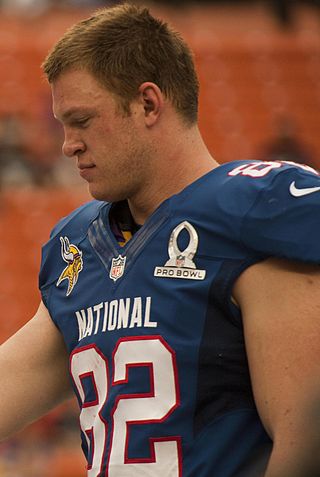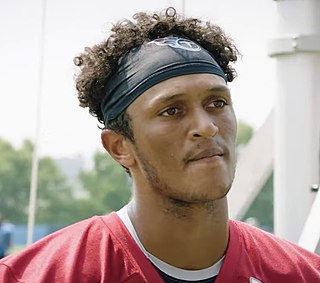
Earl Louis "Curly" Lambeau was an American professional football player and coach in the National Football League (NFL). Lambeau, along with his friend and fellow Green Bay, Wisconsin native George Whitney Calhoun, founded the Green Bay Packers in 1919, serving as team captain in the team's first year before becoming player-coach in 1920. As a player, Lambeau lined up as a halfback, which in the early years of the NFL was the premier position. He was the team's primary runner and passer, accounting for 35 touchdowns in 77 games. He won his only NFL championship as a player in 1929.

Paul Vernon Hornung, nicknamed "the Golden Boy", was an American professional football player who was a Hall of Fame running back for the Green Bay Packers of the National Football League (NFL) from 1957 to 1966. He played on teams that won four NFL titles and the first Super Bowl. He is the first Heisman Trophy winner to be selected as the first overall selection in the NFL Draft, play pro football, win the NFL most valuable player award, and be inducted into both the professional and college football halls of fame. Packers coach Vince Lombardi stated that Hornung was "the greatest player I ever coached."

Donald Montgomery Hutson was an American professional football player and assistant coach in the National Football League (NFL). He played as an end and spent his entire 11-year professional career with the Green Bay Packers. Under head coach Curly Lambeau, Hutson led the Packers to four NFL Championship Games, winning three: 1936, 1939, and 1944.
In American and Canadian football, a single-wing formation was a precursor to the modern spread or shotgun formation. The term usually connotes formations in which the snap is tossed rather than handed—formations with one wingback and a handed snap are commonly called "wing T" or "winged T".

Herbert Dorsey Levens is a former American football running back in the National Football League (NFL). He was drafted by the Green Bay Packers in the fifth round of the 1994 NFL Draft. He helped the Packers win the Vince Lombardi Trophy in Super Bowl XXXI against the New England Patriots. He played college football at Notre Dame and later Georgia Tech.

An option offense is an American football offensive system in which a key player has several "options" of how each play will proceed based upon the actions of the defense. Traditionally, option-based offenses rely on running plays, though most mix in forward passes from an option formation as a change of pace.

Arnold Charles Herber was an American football quarterback who played in the National Football League (NFL) for 13 seasons, primarily with the Green Bay Packers. During his Packers tenure from 1930 to 1940, he led the league in passing yards and touchdowns three times and won four NFL Championship Games. Herber retired after 11 seasons in Green Bay, but returned in 1944 with New York Giants, where he played his final two seasons. He was inducted to the Pro Football Hall of Fame in 1966.
Richard Franklin Mirer is a former American football quarterback who played in the National Football League (NFL) for 12 seasons. He played college football at Notre Dame and was selected second overall by the Seattle Seahawks in the 1993 NFL Draft. In his first season, Mirer set the rookie records for passing yards, attempts, and completions. Unable to duplicate his success, however, Mirer was traded after four seasons to the Chicago Bears. He spent the remainder of his career with the New York Jets, San Francisco 49ers, Oakland Raiders, and Detroit Lions, mostly as a backup. Mirer is considered one of the biggest busts in NFL history.

In American football, a T formation is a formation used by the offensive team in which three running backs line up in a row about five yards behind the quarterback, forming the shape of a "T".
Francis Dale "Hap" Moran was a collegiate and professional American football player. He played mainly at halfback for Carnegie Tech (1922), Grinnell College (1923–1925), the Frankford Yellow Jackets (1926), the Chicago Cardinals (1927), the Pottsville Maroons (1928), and the New York Giants (1929–1933). When he retired from the NFL in 1933, he held the league records for the longest run from scrimmage and most yards receiving in a single game. His 91-yard run remained a New York Giants record for 75 years until it was broken by Tiki Barber on December 31, 2005.
John Petitbon was an American football player.
In American football, the A formation was a variation of the single-wing formation used with great success by the New York Giants of the 1930s and early 1940s. This formation was masterminded by Giants coach Steve Owen and relied heavily upon Hall of Fame center Mel Hein for its success.

Cecil Frank Isbell was an American football quarterback and coach. He played 5 seasons in the National Football League (NFL) with the Green Bay Packers, leading them to the NFL Championship in 1939. He retired after the 1942 season to become an assistant coach at his alma mater, Purdue University, and the following year became its head coach for three seasons.
The 1936 season was the Chicago Bears' 17th in the National Football League and 14th season under head coach George Halas. The team was able to improve on their 6–4–2 record from 1935 and finished with a 9–3 record. The team also finished in second place in the Western Division behind the Green Bay Packers. After week 10, the Bears were tied with the Packers in first place with identical 9–1 records, having split their season series. However, the club swooned at the end of the year, losing their last two games on the road to Detroit and the Cardinals. Green Bay went on to easily defeat the Boston Redskins and win the NFL title.

Ryan Brett Grant is a former American football running back in the National Football League (NFL). Grant played college football at Notre Dame where he rushed for over 1,000 yards in his only year as the starting running back. He originally signed with the New York Giants as an undrafted free agent in 2005 but never played a game for them. Shortly before the 2007 season, Grant was traded to the Green Bay Packers in exchange for a future sixth-round draft pick. He would go on to play for the Packers for six seasons.

John Henry Mohardt was an American football and baseball player and medical doctor.

Kyle Daniel Rudolph is an American football tight end for the Tampa Bay Buccaneers of the National Football League (NFL). He played college football at Notre Dame, and was drafted by the Minnesota Vikings in the second round of the 2011 NFL Draft. He has been selected to two Pro Bowls. He also played for the New York Giants.

DeShone Allen Kizer is an American football quarterback who has played in the National Football League (NFL) for four seasons. He played college football at Notre Dame and was selected by the Cleveland Browns in the second round of the 2017 NFL Draft. Kizer served as the Browns' starter during his rookie season, but his tenure lasted only one year after he went winless and led the league in interceptions. Traded to the Green Bay Packers, he spent one season as a backup in 2018 and also held backup roles with the Las Vegas Raiders and Tennessee Titans.
In gridiron football, a shift refers to the movement of an offensive player prior to the snap.












